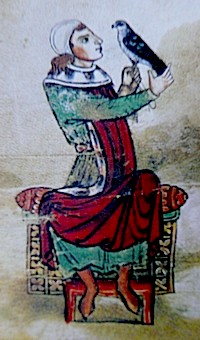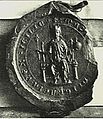Manfred, King of Sicily
| Manfred | |
|---|---|
Charles I | |
| Born | Manfred Lancia 1232 Venosa, Kingdom of Sicily |
| Died | 26 February 1266 (aged 34) Benevento, Kingdom of Sicily |
| Spouse | |
Hohenstaufen | |
| Father | Frederick II, Holy Roman Emperor |
| Mother | Bianca Lancia |
Manfred (
Early life
Manfred was born in
At Frederick's death in 1250, Manfred, although only about 18 years old, acted loyally and with vigour in the execution of his trust. The Kingdom was in turmoil, mainly due to rebellions spurred by Pope Innocent IV. Manfred was able to subdue numerous rebel cities, with the exception of Naples.[5] Manfred attempted in 1251 to make concessions to Pope Innocent to stave off the prospect of war, but the attempt failed.[6] When Conrad IV, Manfred's legitimate brother, appeared in southern Italy in 1252, his authority was quickly and generally acknowledged.[7] Conrad quickly stripped Manfred of all his fiefs by limiting his authority solely to the principality of Taranto.[6] In October 1253, Naples fell into the hands of Conrad. Conrad made the pope the guardian of Conradin, his infant son, and named the Margrave Berthold of Hohenberg, a powerful German baron,[6] as Conradin's regent.[8][A]
In May 1254 Conrad died of
-
Seal of Manfred
-
Coat of arms of King Manfred
Kingship

On 10 August 1258, taking advantage of Conradin's rumoured death, Manfred was crowned King of Sicily at
Terrified by these proceedings, the new
Charles' army, some 30,000 strong, entered Italy from the
At the Battle of Benevento Charles captured Helena, Manfred's second wife, and imprisoned her. She lived five years later in captivity in the castle of Nocera Inferiore where she died in 1271. Manfred's son-in-law Peter III eventually became King Peter I of Sicily from 1282 after the Sicilian Vespers expelled the French from the island again.
The modern city of
Marriages and children
Manfred was married twice. His first wife was
Manfred's second wife was
Manfred had at least one illegitimate child, a daughter named Flordelis (d. 27 February 1297), who married Ranieri Della Gherardesca, Count of Donoratico and Bolgheri.[17]
Legacy and reception

Medieval reception
Contemporaries praised the noble and magnanimous character of Manfred, who was renowned for his physical beauty and intellectual attainments.[7]
In the
Dante's placing of Manfred in Purgatory is surprising given Manfred's excommunication by multiple popes.[24] Manfred's placement in Purgatory is indicative of Dante's dislike of popes' use of excommunication as a political and policy tool.[24] According to Dante, Manfred's excommunication does not make it impossible for him to make it through Purgatory and, eventually, into Paradise. Dante adds to this characterization of Manfred and the Church by describing how the Church ordered Manfred's bones unearthed after his death and thrown into a river outside the kingdom in fear that his gravesite would inspire the development of a cult around it.[24][25]
Manfred's presence in Purgatorio also holds a more general symbolic value. Robert Hollander argues that Manfred's time in Purgatory should be seen as a symbol of hope, given that Manfred's final statement in Purgatorio, Canto III is that "hope maintains a thread of green" (speranza ha fior del verde) (Purgatorio III.135), which is paraphrased as death not eliminating hope so long as even a bit of hope is there.[26]
Modern reception
Manfred formed the subject of dramas by
Manfred's name was borrowed by the English author Horace Walpole for the main character of his short novel The Castle of Otranto (1764). Montague Summers, in his 1924 edition of this work, showed that some details of Manfred of Sicily's real history inspired the novelist.[27] The name was re-borrowed by Lord Byron for his dramatic poem Manfred (1817).[28]
Inspired by Byron's poem, Manfred was adapted musically by Robert Schumann in 1852, in a composition entitled Manfred: Dramatic Poem with Music in Three Parts, and later by Pyotr Ilyich Tchaikovsky in his Manfred Symphony (1885).[29]
King Manfred (König Manfred), Op. 93 is a grand romantic opera in 5 acts by Carl Reinecke to libretto by Friedrich Roeber Friedrich Roeber. It was composed in 1866 and staged in 1867.[30][31]
Notes
- ^ Lomax (2013, p. 440) gives Berthold's title as bailiff. Venning & Frankopan (2015, p. 335) asserts that Berthold was Conradin's regent over Apulia but Pietro Ruffo the regent over Sicily.
References
- ^ Barber 2004, p. 233.
- ^ Lock 2013, p. 179.
- ^ Runciman 1958, p. 27.
- ^ Abulafia 1992, p. 406.
- ^ Runciman 1958, pp. 28–29.
- ^ a b c d e Lomax 2013, p. 440.
- ^ a b c d e f g Chisholm 1911, p. 568.
- ^ Previté-Orton 1975, p. 696.
- ^ Fried 2015, p. 282.
- ^ Venning & Frankopan 2015, p. 335.
- ^ a b Kelly & Walsh 2010, p. 195.
- ^ Berg 1993, p. 113.
- ^ Domenico 2002, p. 25.
- ^ Runciman 1958, pp. 92, 94.
- ^ a b Runciman 1958, p. 94.
- ^ a b Runciman 1958, p. 43.
- ^ a b c Koller 2007.
- ^ Bennett & Weikert 2016, p. 144.
- ^ a b Gregorovius 2010, p. 537, n. 1.
- ^ Bennett & Weikert 2016, pp. 145–46.
- ^ Haverkamp 1988, p. 267.
- ISBN 978-0385497008.
- ^ Parker, Deborah (12 August 2020). "Regeneration and Degeneration". Dante Society.
- ^ )
- ^ "Manfred". danteworlds.laits.utexas.edu. Retrieved 8 November 2021.
- ISBN 0385497008.
- S2CID 153695496.
- ISSN 1844-4369.
- S2CID 194043894.
- ^ Preface by Christoph Schlüren, 2003 – Final paragraph by Bradford Robinson, 2007
- ^ Klaus Tischendorf. Booklet notes to Marco Polo 8.223117 / Naxos 8.555397 Archived 22 April 2022 at the Wayback Machine
Sources
- Abulafia, David (1992). Frederick II: A Medieval Emperor. Oxford University Press. ISBN 978-0-19-508040-7.
- Barber, Malcolm (2 August 2004). The Two Cities: Medieval Europe 1050–1320. Routledge. ISBN 978-1-134-68751-0.
- Bauer, Susan Wise (23 September 2013). The History of the Renaissance World: From the Rediscovery of Aristotle to the Conquest of Constantinople. W. W. Norton. pp. 402–. ISBN 978-0-393-24067-2.
- Berg, Beverly (1993). "Manfred of Sicily and Urban IV: negotiations of 1262". Mediaeval Studies. 55: 111–136. .
- Chisholm, Hugh, ed. (1911). . Encyclopædia Britannica. Vol. 17 (11th ed.). Cambridge University Press. p. 568.
- Domenico, Roy Palmer (2002). The Regions of Italy: A Reference Guide to History and Culture. Greenwood Publishing Group. ISBN 978-0-313-30733-1.
- Fried, Johannes (13 January 2015). The Middle Ages. Harvard University Press. ISBN 978-0-674-05562-9.
- Haverkamp, Alfred (1988). Medieval Germany, 1056–1273. Oxford University Press.
- Gregorovius, Ferdinand (2010) [1897]. History of the City of Rome in the Middle Ages. Vol. 5, Part 2. Cambridge University Press.
- Kelly, John Norman Davidson; Walsh, Michael J. (2010). A Dictionary of Popes. Oxford University Press. ISBN 978-0-19-929581-4.
- Koller, Walter (2007). "MANFREDI, re di Sicilia". Dizionario Biografico (in Italian). Vol. 68. Rome.
{{cite encyclopedia}}: CS1 maint: location missing publisher (link) - Lock, Peter (15 April 2013). The Routledge Companion to the Crusades. Routledge. pp. 6–. ISBN 978-1-135-13137-1.
- Lomax, John (18 October 2013). "Manfred". In Richard K. Emmerson (ed.). Key Figures in Medieval Europe: An Encyclopedia. Routledge. pp. 440–. ISBN 978-1-136-77519-2.
- Matthew, Donald (30 July 1992). The Norman Kingdom of Sicily. Cambridge University Press. pp. 363–. ISBN 978-0-521-26911-7.
- Parks, Annette, "'Thy Father's Valiancy Has Proved No Boon": The Fates of Helena Angelina Doukaina and Her Children, in Bennett, Matthew; Weikert, Katherine (13 September 2016). Medieval Hostageship c.700-c.1500: Hostage, Captive, Prisoner of War, Guarantee, Peacemaker. Taylor & Francis. pp. 230–. ISBN 978-1-134-99612-4.
- Previté-Orton, C. W. (24 July 1975). Cambridge Medieval History, Shorter: Volume 2, The Twelfth Century to the Renaissance. CUP Archive. pp. 696–. ISBN 978-0-521-09977-6.
- Runciman, Sir Steven (1958). The Sicilian Vespers: A History of the Mediterranean World in the Later Thirteenth Century. Cambridge University Press. OCLC 930490694.
- Venning, Timothy; Frankopan, Peter (1 May 2015). A Chronology of the Crusades. Routledge. pp. 335–. ISBN 978-1-317-49643-4.
- Weiler, Björn K. U. (2006). Henry III of England and the Staufen Empire, 1216-1272. Boydell & Brewer. pp. 156–. ISBN 978-0-86193-280-1.
Further reading
- Mendola, Louis (2016). Frederick, Conrad and Manfred of Hohenstaufen, Kings of Sicily: the chronicle of Nicholas of Jamsilla 1210–1258. New York: Trinacria. OCLC 949866013.
- Momigliano, Eucardio (1963). Manfredi. Milan: Dall'Oglio. OCLC 797020469.
External links
- Markus Brantl: Regesten und Itinerar König Manfreds von Sizilien, 2005 (XML-version, pdf-version, 6 MB)(in German)


